Flood Management Policy and Legislation in the UK: A Detailed Report
VerifiedAdded on 2023/01/06
|9
|2712
|23
Report
AI Summary
This report provides an in-depth analysis of flood management policies and legislation in the United Kingdom. It begins with an introduction to flood risk and the role of governmental bodies in mitigating its impact. The main body identifies and describes key policies and legislation, including the Civil Contingency Act 2004, the Flood and Water Management Act 2010, and the National Flood Resilience Review 2016, as well as the EU Flood Directive. The report then provides examples of implementation, such as the Thames Barrier and river projects, highlighting their effectiveness in protecting London and other areas. A critical evaluation of the effectiveness of these policies and legislations, including the criticisms and inefficiencies, is provided. The report discusses the challenges associated with groundwater flooding and the role of the Environmental Agency. The report concludes by summarizing the key findings and the importance of effective flood risk management for the safety, infrastructure, and economic stability of the UK. This report is designed for students and can be found on Desklib, a platform offering AI-based study tools.
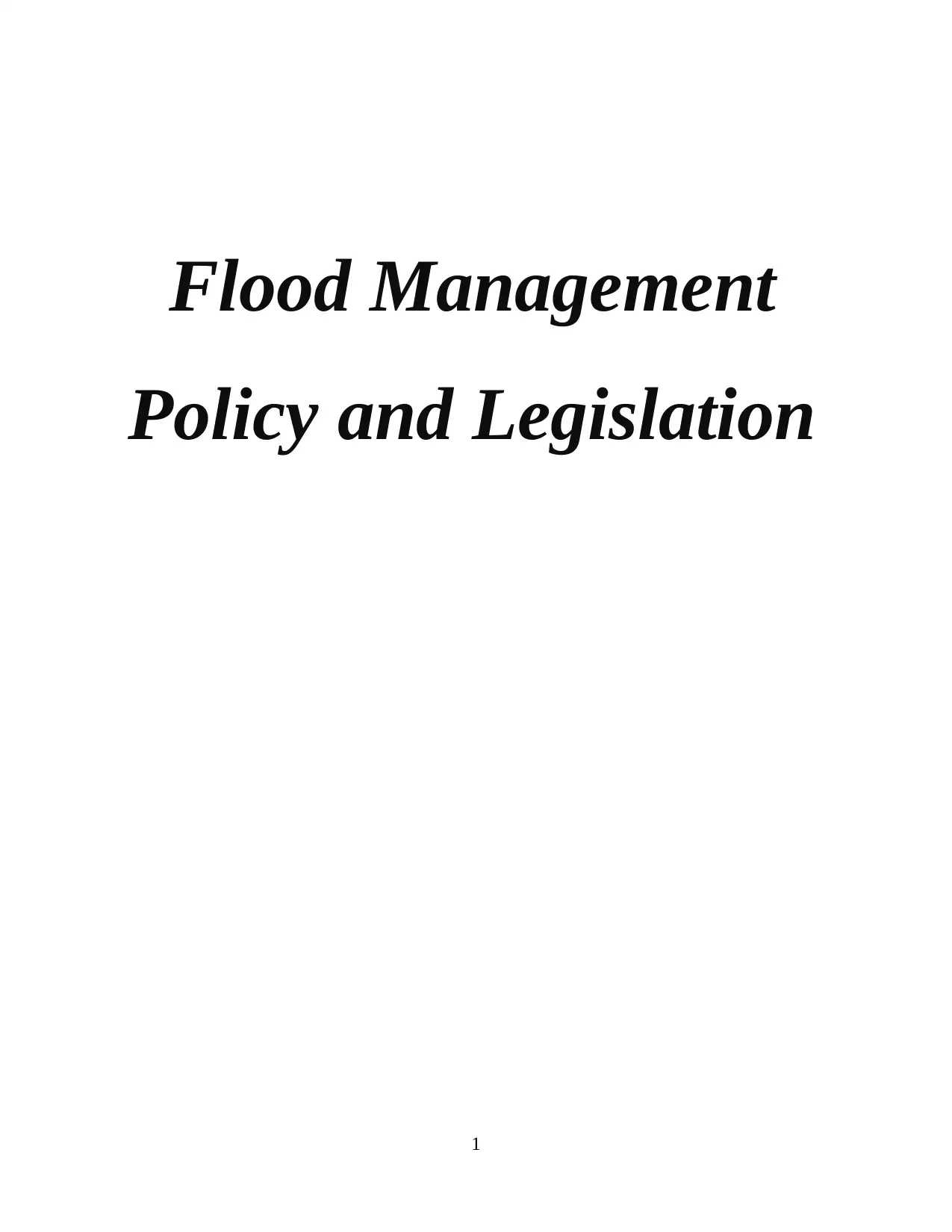
Flood Management
Policy and Legislation
1
Policy and Legislation
1
Paraphrase This Document
Need a fresh take? Get an instant paraphrase of this document with our AI Paraphraser
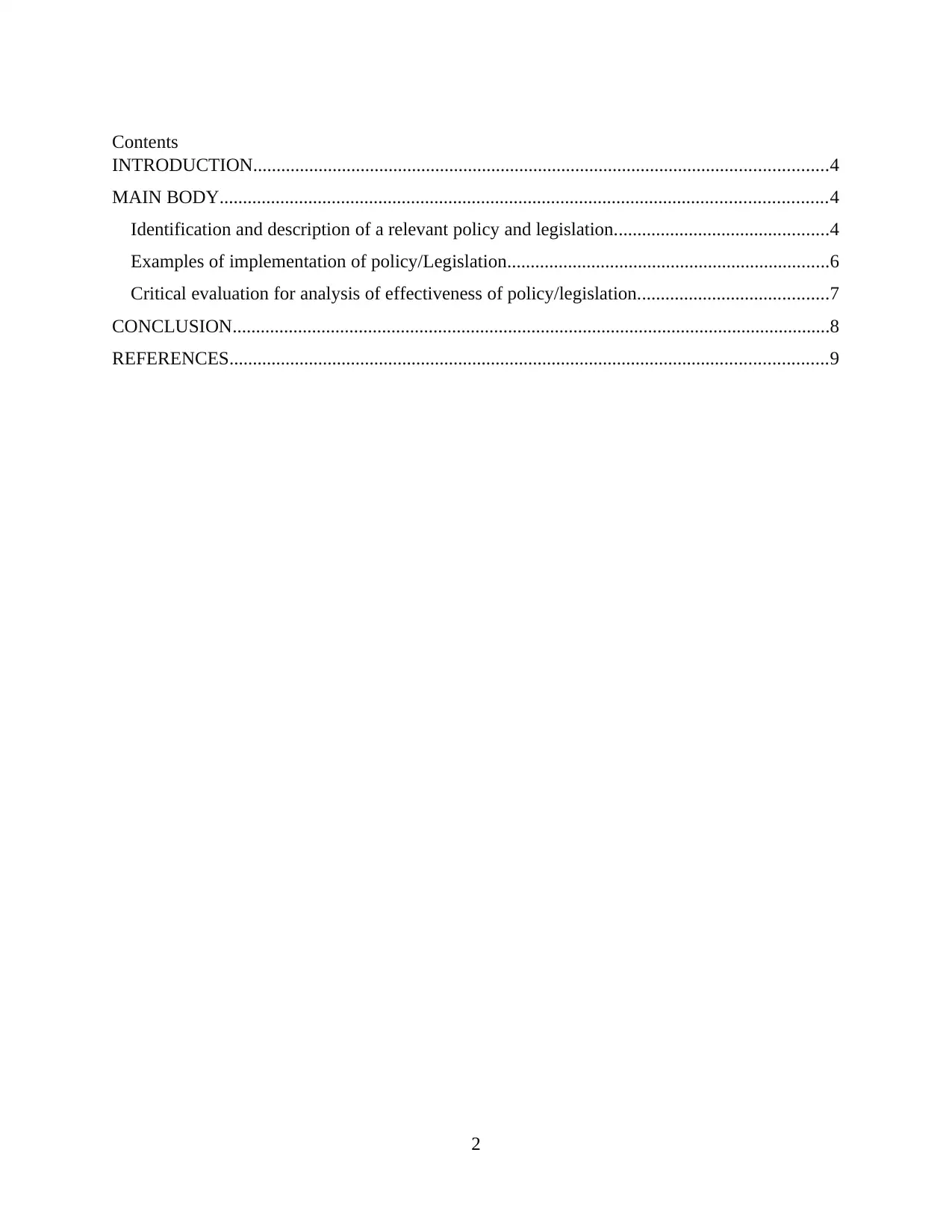
Contents
INTRODUCTION...........................................................................................................................4
MAIN BODY..................................................................................................................................4
Identification and description of a relevant policy and legislation..............................................4
Examples of implementation of policy/Legislation.....................................................................6
Critical evaluation for analysis of effectiveness of policy/legislation.........................................7
CONCLUSION................................................................................................................................8
REFERENCES................................................................................................................................9
2
INTRODUCTION...........................................................................................................................4
MAIN BODY..................................................................................................................................4
Identification and description of a relevant policy and legislation..............................................4
Examples of implementation of policy/Legislation.....................................................................6
Critical evaluation for analysis of effectiveness of policy/legislation.........................................7
CONCLUSION................................................................................................................................8
REFERENCES................................................................................................................................9
2
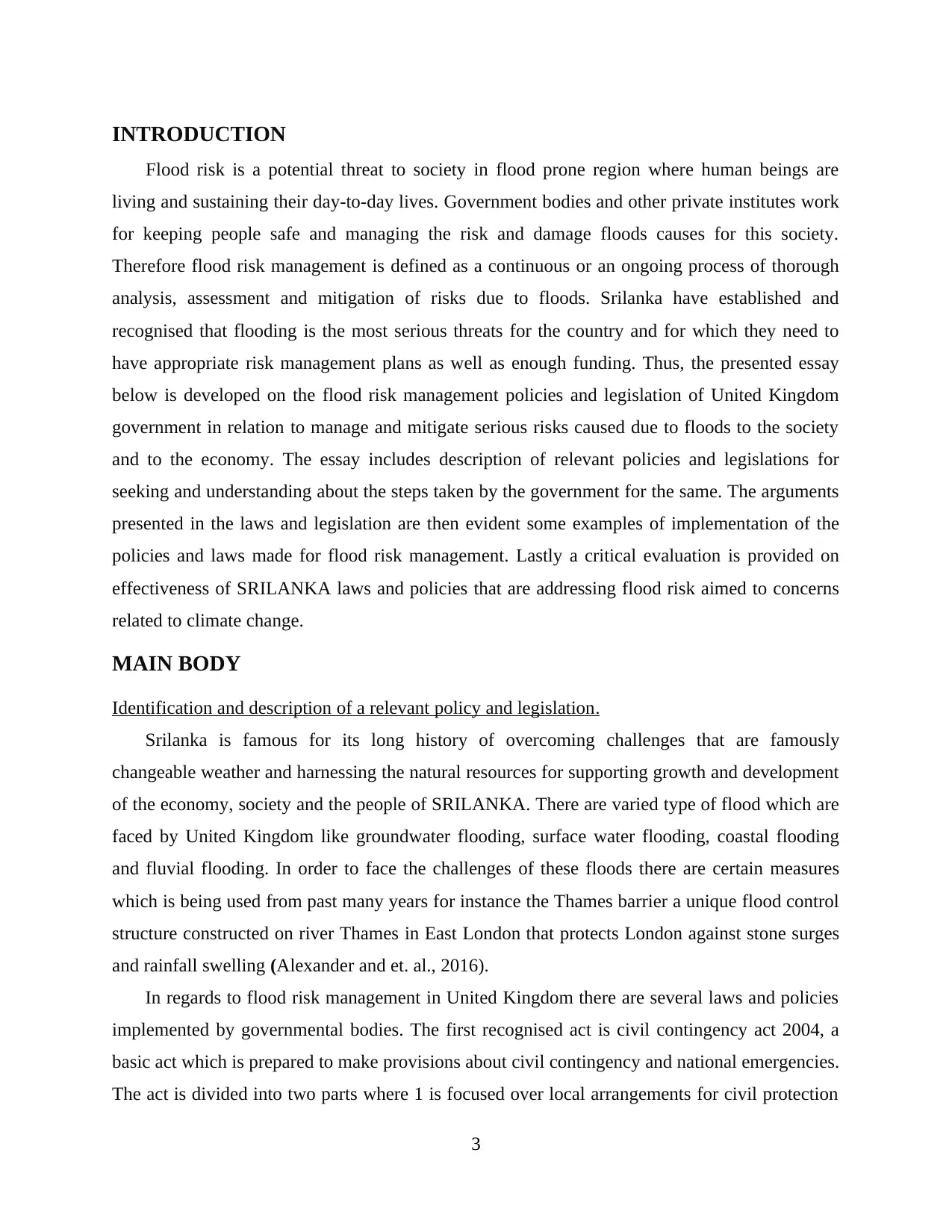
INTRODUCTION
Flood risk is a potential threat to society in flood prone region where human beings are
living and sustaining their day-to-day lives. Government bodies and other private institutes work
for keeping people safe and managing the risk and damage floods causes for this society.
Therefore flood risk management is defined as a continuous or an ongoing process of thorough
analysis, assessment and mitigation of risks due to floods. Srilanka have established and
recognised that flooding is the most serious threats for the country and for which they need to
have appropriate risk management plans as well as enough funding. Thus, the presented essay
below is developed on the flood risk management policies and legislation of United Kingdom
government in relation to manage and mitigate serious risks caused due to floods to the society
and to the economy. The essay includes description of relevant policies and legislations for
seeking and understanding about the steps taken by the government for the same. The arguments
presented in the laws and legislation are then evident some examples of implementation of the
policies and laws made for flood risk management. Lastly a critical evaluation is provided on
effectiveness of SRILANKA laws and policies that are addressing flood risk aimed to concerns
related to climate change.
MAIN BODY
Identification and description of a relevant policy and legislation.
Srilanka is famous for its long history of overcoming challenges that are famously
changeable weather and harnessing the natural resources for supporting growth and development
of the economy, society and the people of SRILANKA. There are varied type of flood which are
faced by United Kingdom like groundwater flooding, surface water flooding, coastal flooding
and fluvial flooding. In order to face the challenges of these floods there are certain measures
which is being used from past many years for instance the Thames barrier a unique flood control
structure constructed on river Thames in East London that protects London against stone surges
and rainfall swelling (Alexander and et. al., 2016).
In regards to flood risk management in United Kingdom there are several laws and policies
implemented by governmental bodies. The first recognised act is civil contingency act 2004, a
basic act which is prepared to make provisions about civil contingency and national emergencies.
The act is divided into two parts where 1 is focused over local arrangements for civil protection
3
Flood risk is a potential threat to society in flood prone region where human beings are
living and sustaining their day-to-day lives. Government bodies and other private institutes work
for keeping people safe and managing the risk and damage floods causes for this society.
Therefore flood risk management is defined as a continuous or an ongoing process of thorough
analysis, assessment and mitigation of risks due to floods. Srilanka have established and
recognised that flooding is the most serious threats for the country and for which they need to
have appropriate risk management plans as well as enough funding. Thus, the presented essay
below is developed on the flood risk management policies and legislation of United Kingdom
government in relation to manage and mitigate serious risks caused due to floods to the society
and to the economy. The essay includes description of relevant policies and legislations for
seeking and understanding about the steps taken by the government for the same. The arguments
presented in the laws and legislation are then evident some examples of implementation of the
policies and laws made for flood risk management. Lastly a critical evaluation is provided on
effectiveness of SRILANKA laws and policies that are addressing flood risk aimed to concerns
related to climate change.
MAIN BODY
Identification and description of a relevant policy and legislation.
Srilanka is famous for its long history of overcoming challenges that are famously
changeable weather and harnessing the natural resources for supporting growth and development
of the economy, society and the people of SRILANKA. There are varied type of flood which are
faced by United Kingdom like groundwater flooding, surface water flooding, coastal flooding
and fluvial flooding. In order to face the challenges of these floods there are certain measures
which is being used from past many years for instance the Thames barrier a unique flood control
structure constructed on river Thames in East London that protects London against stone surges
and rainfall swelling (Alexander and et. al., 2016).
In regards to flood risk management in United Kingdom there are several laws and policies
implemented by governmental bodies. The first recognised act is civil contingency act 2004, a
basic act which is prepared to make provisions about civil contingency and national emergencies.
The act is divided into two parts where 1 is focused over local arrangements for civil protection
3
⊘ This is a preview!⊘
Do you want full access?
Subscribe today to unlock all pages.

Trusted by 1+ million students worldwide
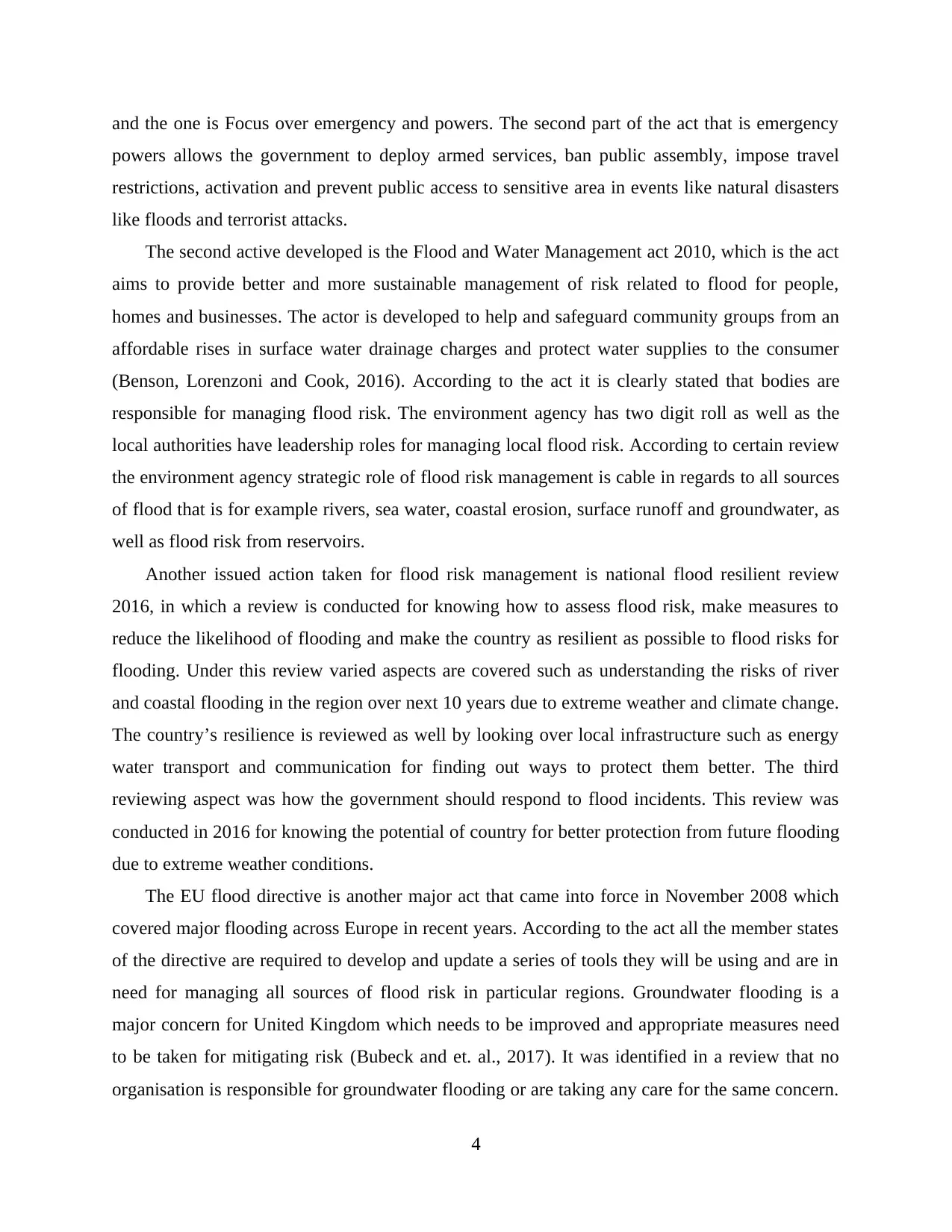
and the one is Focus over emergency and powers. The second part of the act that is emergency
powers allows the government to deploy armed services, ban public assembly, impose travel
restrictions, activation and prevent public access to sensitive area in events like natural disasters
like floods and terrorist attacks.
The second active developed is the Flood and Water Management act 2010, which is the act
aims to provide better and more sustainable management of risk related to flood for people,
homes and businesses. The actor is developed to help and safeguard community groups from an
affordable rises in surface water drainage charges and protect water supplies to the consumer
(Benson, Lorenzoni and Cook, 2016). According to the act it is clearly stated that bodies are
responsible for managing flood risk. The environment agency has two digit roll as well as the
local authorities have leadership roles for managing local flood risk. According to certain review
the environment agency strategic role of flood risk management is cable in regards to all sources
of flood that is for example rivers, sea water, coastal erosion, surface runoff and groundwater, as
well as flood risk from reservoirs.
Another issued action taken for flood risk management is national flood resilient review
2016, in which a review is conducted for knowing how to assess flood risk, make measures to
reduce the likelihood of flooding and make the country as resilient as possible to flood risks for
flooding. Under this review varied aspects are covered such as understanding the risks of river
and coastal flooding in the region over next 10 years due to extreme weather and climate change.
The country’s resilience is reviewed as well by looking over local infrastructure such as energy
water transport and communication for finding out ways to protect them better. The third
reviewing aspect was how the government should respond to flood incidents. This review was
conducted in 2016 for knowing the potential of country for better protection from future flooding
due to extreme weather conditions.
The EU flood directive is another major act that came into force in November 2008 which
covered major flooding across Europe in recent years. According to the act all the member states
of the directive are required to develop and update a series of tools they will be using and are in
need for managing all sources of flood risk in particular regions. Groundwater flooding is a
major concern for United Kingdom which needs to be improved and appropriate measures need
to be taken for mitigating risk (Bubeck and et. al., 2017). It was identified in a review that no
organisation is responsible for groundwater flooding or are taking any care for the same concern.
4
powers allows the government to deploy armed services, ban public assembly, impose travel
restrictions, activation and prevent public access to sensitive area in events like natural disasters
like floods and terrorist attacks.
The second active developed is the Flood and Water Management act 2010, which is the act
aims to provide better and more sustainable management of risk related to flood for people,
homes and businesses. The actor is developed to help and safeguard community groups from an
affordable rises in surface water drainage charges and protect water supplies to the consumer
(Benson, Lorenzoni and Cook, 2016). According to the act it is clearly stated that bodies are
responsible for managing flood risk. The environment agency has two digit roll as well as the
local authorities have leadership roles for managing local flood risk. According to certain review
the environment agency strategic role of flood risk management is cable in regards to all sources
of flood that is for example rivers, sea water, coastal erosion, surface runoff and groundwater, as
well as flood risk from reservoirs.
Another issued action taken for flood risk management is national flood resilient review
2016, in which a review is conducted for knowing how to assess flood risk, make measures to
reduce the likelihood of flooding and make the country as resilient as possible to flood risks for
flooding. Under this review varied aspects are covered such as understanding the risks of river
and coastal flooding in the region over next 10 years due to extreme weather and climate change.
The country’s resilience is reviewed as well by looking over local infrastructure such as energy
water transport and communication for finding out ways to protect them better. The third
reviewing aspect was how the government should respond to flood incidents. This review was
conducted in 2016 for knowing the potential of country for better protection from future flooding
due to extreme weather conditions.
The EU flood directive is another major act that came into force in November 2008 which
covered major flooding across Europe in recent years. According to the act all the member states
of the directive are required to develop and update a series of tools they will be using and are in
need for managing all sources of flood risk in particular regions. Groundwater flooding is a
major concern for United Kingdom which needs to be improved and appropriate measures need
to be taken for mitigating risk (Bubeck and et. al., 2017). It was identified in a review that no
organisation is responsible for groundwater flooding or are taking any care for the same concern.
4
Paraphrase This Document
Need a fresh take? Get an instant paraphrase of this document with our AI Paraphraser
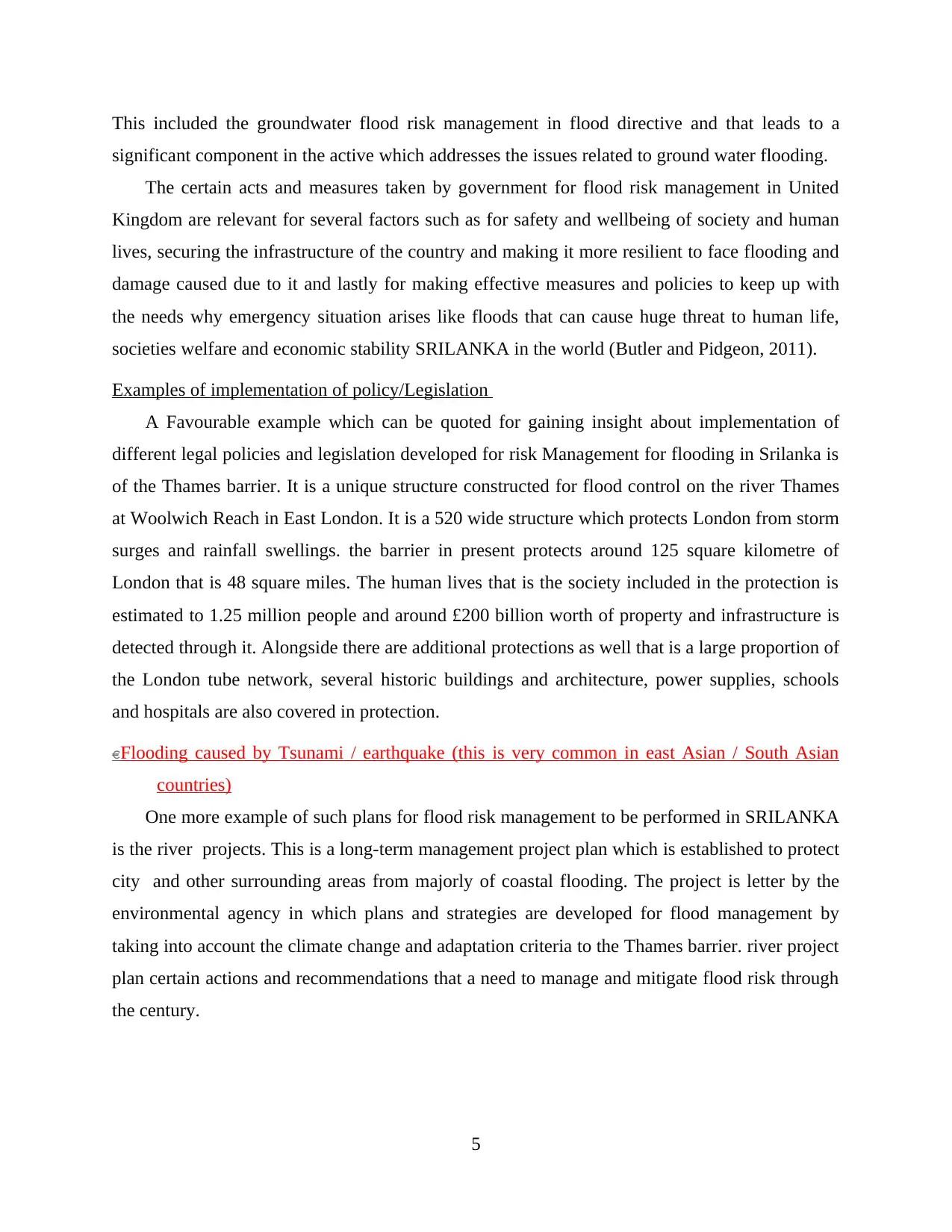
This included the groundwater flood risk management in flood directive and that leads to a
significant component in the active which addresses the issues related to ground water flooding.
The certain acts and measures taken by government for flood risk management in United
Kingdom are relevant for several factors such as for safety and wellbeing of society and human
lives, securing the infrastructure of the country and making it more resilient to face flooding and
damage caused due to it and lastly for making effective measures and policies to keep up with
the needs why emergency situation arises like floods that can cause huge threat to human life,
societies welfare and economic stability SRILANKA in the world (Butler and Pidgeon, 2011).
Examples of implementation of policy/Legislation
A Favourable example which can be quoted for gaining insight about implementation of
different legal policies and legislation developed for risk Management for flooding in Srilanka is
of the Thames barrier. It is a unique structure constructed for flood control on the river Thames
at Woolwich Reach in East London. It is a 520 wide structure which protects London from storm
surges and rainfall swellings. the barrier in present protects around 125 square kilometre of
London that is 48 square miles. The human lives that is the society included in the protection is
estimated to 1.25 million people and around £200 billion worth of property and infrastructure is
detected through it. Alongside there are additional protections as well that is a large proportion of
the London tube network, several historic buildings and architecture, power supplies, schools
and hospitals are also covered in protection.
Flooding caused by Tsunami / earthquake (this is very common in east Asian / South Asian
countries)
One more example of such plans for flood risk management to be performed in SRILANKA
is the river projects. This is a long-term management project plan which is established to protect
city and other surrounding areas from majorly of coastal flooding. The project is letter by the
environmental agency in which plans and strategies are developed for flood management by
taking into account the climate change and adaptation criteria to the Thames barrier. river project
plan certain actions and recommendations that a need to manage and mitigate flood risk through
the century.
5
significant component in the active which addresses the issues related to ground water flooding.
The certain acts and measures taken by government for flood risk management in United
Kingdom are relevant for several factors such as for safety and wellbeing of society and human
lives, securing the infrastructure of the country and making it more resilient to face flooding and
damage caused due to it and lastly for making effective measures and policies to keep up with
the needs why emergency situation arises like floods that can cause huge threat to human life,
societies welfare and economic stability SRILANKA in the world (Butler and Pidgeon, 2011).
Examples of implementation of policy/Legislation
A Favourable example which can be quoted for gaining insight about implementation of
different legal policies and legislation developed for risk Management for flooding in Srilanka is
of the Thames barrier. It is a unique structure constructed for flood control on the river Thames
at Woolwich Reach in East London. It is a 520 wide structure which protects London from storm
surges and rainfall swellings. the barrier in present protects around 125 square kilometre of
London that is 48 square miles. The human lives that is the society included in the protection is
estimated to 1.25 million people and around £200 billion worth of property and infrastructure is
detected through it. Alongside there are additional protections as well that is a large proportion of
the London tube network, several historic buildings and architecture, power supplies, schools
and hospitals are also covered in protection.
Flooding caused by Tsunami / earthquake (this is very common in east Asian / South Asian
countries)
One more example of such plans for flood risk management to be performed in SRILANKA
is the river projects. This is a long-term management project plan which is established to protect
city and other surrounding areas from majorly of coastal flooding. The project is letter by the
environmental agency in which plans and strategies are developed for flood management by
taking into account the climate change and adaptation criteria to the Thames barrier. river project
plan certain actions and recommendations that a need to manage and mitigate flood risk through
the century.
5
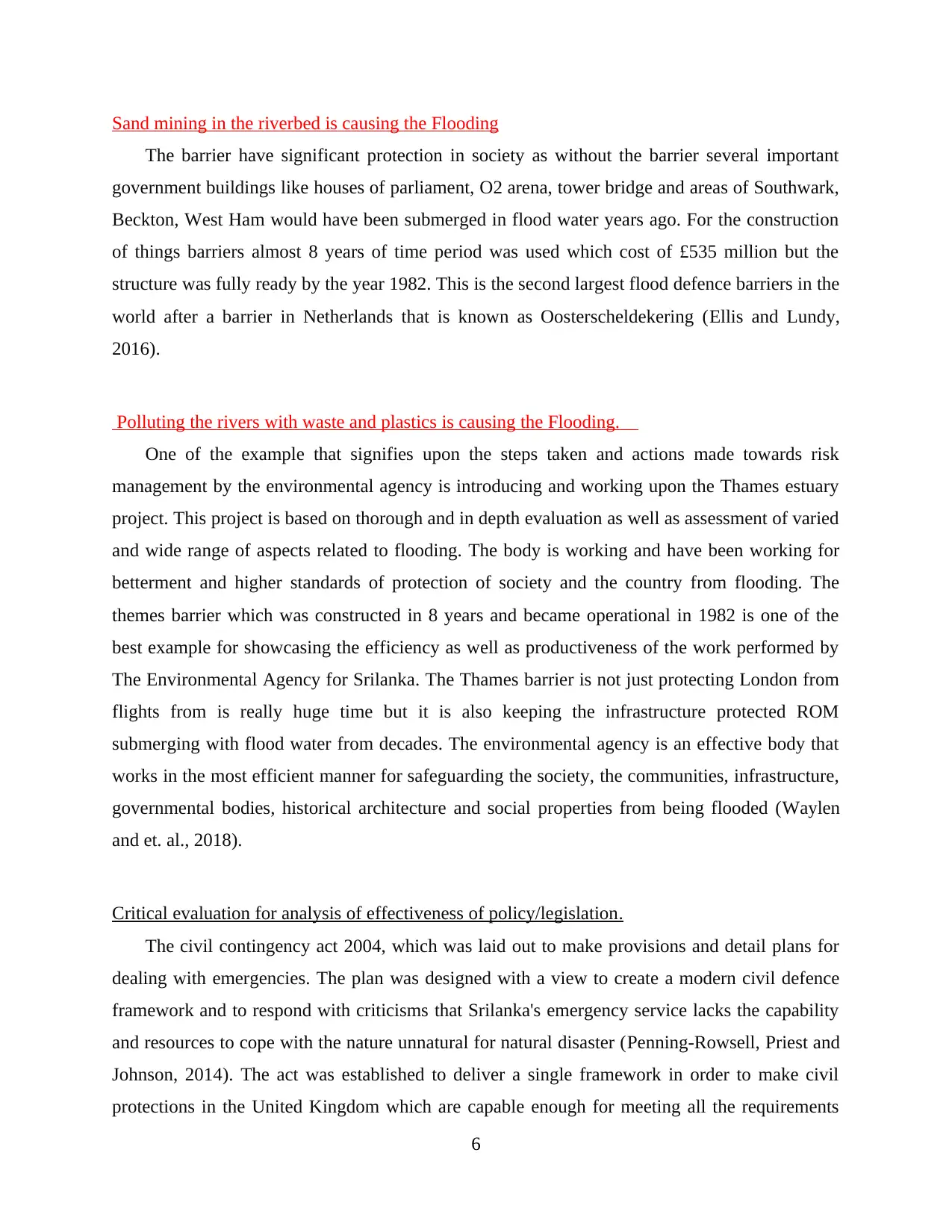
Sand mining in the riverbed is causing the Flooding
The barrier have significant protection in society as without the barrier several important
government buildings like houses of parliament, O2 arena, tower bridge and areas of Southwark,
Beckton, West Ham would have been submerged in flood water years ago. For the construction
of things barriers almost 8 years of time period was used which cost of £535 million but the
structure was fully ready by the year 1982. This is the second largest flood defence barriers in the
world after a barrier in Netherlands that is known as Oosterscheldekering (Ellis and Lundy,
2016).
Polluting the rivers with waste and plastics is causing the Flooding.
One of the example that signifies upon the steps taken and actions made towards risk
management by the environmental agency is introducing and working upon the Thames estuary
project. This project is based on thorough and in depth evaluation as well as assessment of varied
and wide range of aspects related to flooding. The body is working and have been working for
betterment and higher standards of protection of society and the country from flooding. The
themes barrier which was constructed in 8 years and became operational in 1982 is one of the
best example for showcasing the efficiency as well as productiveness of the work performed by
The Environmental Agency for Srilanka. The Thames barrier is not just protecting London from
flights from is really huge time but it is also keeping the infrastructure protected ROM
submerging with flood water from decades. The environmental agency is an effective body that
works in the most efficient manner for safeguarding the society, the communities, infrastructure,
governmental bodies, historical architecture and social properties from being flooded (Waylen
and et. al., 2018).
Critical evaluation for analysis of effectiveness of policy/legislation.
The civil contingency act 2004, which was laid out to make provisions and detail plans for
dealing with emergencies. The plan was designed with a view to create a modern civil defence
framework and to respond with criticisms that Srilanka's emergency service lacks the capability
and resources to cope with the nature unnatural for natural disaster (Penning-Rowsell, Priest and
Johnson, 2014). The act was established to deliver a single framework in order to make civil
protections in the United Kingdom which are capable enough for meeting all the requirements
6
The barrier have significant protection in society as without the barrier several important
government buildings like houses of parliament, O2 arena, tower bridge and areas of Southwark,
Beckton, West Ham would have been submerged in flood water years ago. For the construction
of things barriers almost 8 years of time period was used which cost of £535 million but the
structure was fully ready by the year 1982. This is the second largest flood defence barriers in the
world after a barrier in Netherlands that is known as Oosterscheldekering (Ellis and Lundy,
2016).
Polluting the rivers with waste and plastics is causing the Flooding.
One of the example that signifies upon the steps taken and actions made towards risk
management by the environmental agency is introducing and working upon the Thames estuary
project. This project is based on thorough and in depth evaluation as well as assessment of varied
and wide range of aspects related to flooding. The body is working and have been working for
betterment and higher standards of protection of society and the country from flooding. The
themes barrier which was constructed in 8 years and became operational in 1982 is one of the
best example for showcasing the efficiency as well as productiveness of the work performed by
The Environmental Agency for Srilanka. The Thames barrier is not just protecting London from
flights from is really huge time but it is also keeping the infrastructure protected ROM
submerging with flood water from decades. The environmental agency is an effective body that
works in the most efficient manner for safeguarding the society, the communities, infrastructure,
governmental bodies, historical architecture and social properties from being flooded (Waylen
and et. al., 2018).
Critical evaluation for analysis of effectiveness of policy/legislation.
The civil contingency act 2004, which was laid out to make provisions and detail plans for
dealing with emergencies. The plan was designed with a view to create a modern civil defence
framework and to respond with criticisms that Srilanka's emergency service lacks the capability
and resources to cope with the nature unnatural for natural disaster (Penning-Rowsell, Priest and
Johnson, 2014). The act was established to deliver a single framework in order to make civil
protections in the United Kingdom which are capable enough for meeting all the requirements
6
⊘ This is a preview!⊘
Do you want full access?
Subscribe today to unlock all pages.

Trusted by 1+ million students worldwide
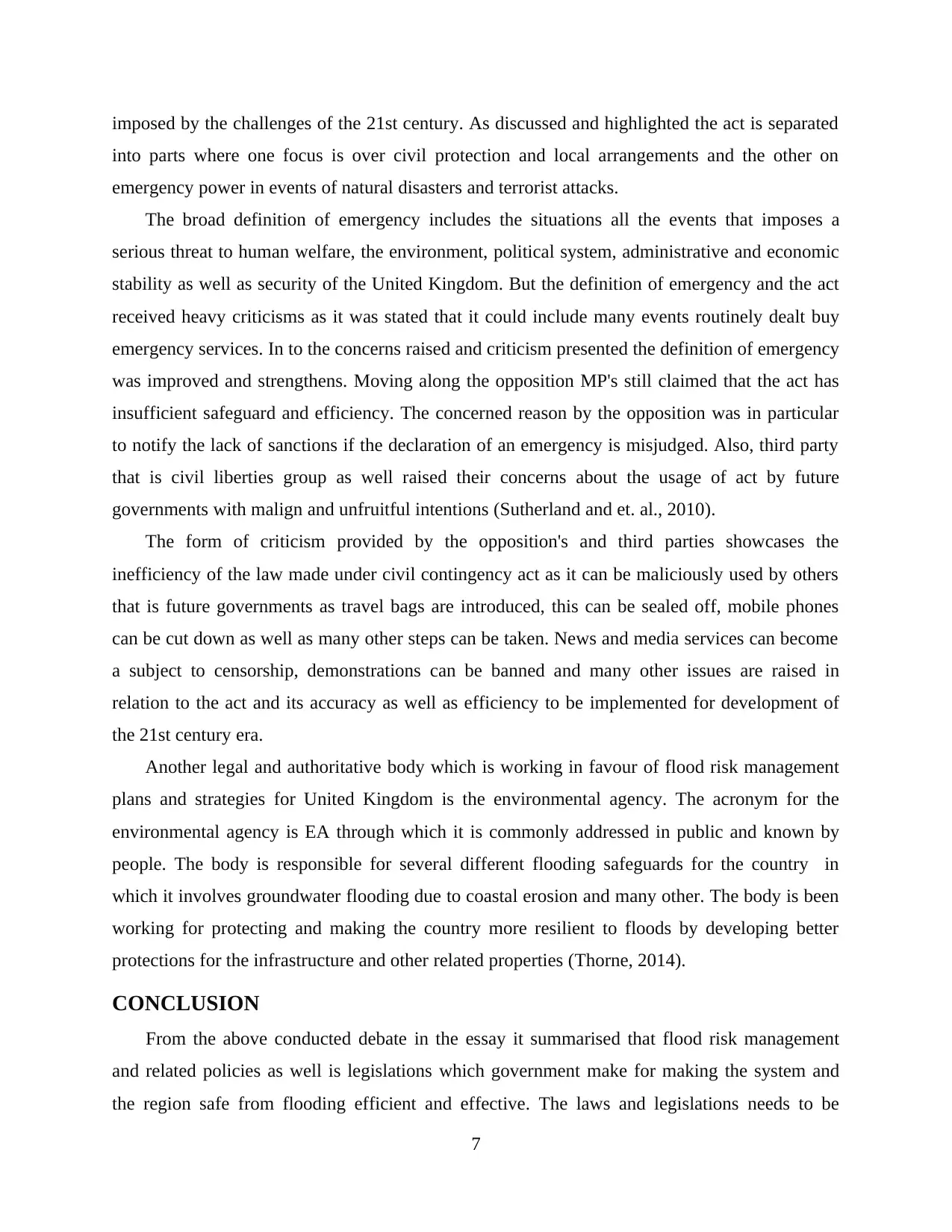
imposed by the challenges of the 21st century. As discussed and highlighted the act is separated
into parts where one focus is over civil protection and local arrangements and the other on
emergency power in events of natural disasters and terrorist attacks.
The broad definition of emergency includes the situations all the events that imposes a
serious threat to human welfare, the environment, political system, administrative and economic
stability as well as security of the United Kingdom. But the definition of emergency and the act
received heavy criticisms as it was stated that it could include many events routinely dealt buy
emergency services. In to the concerns raised and criticism presented the definition of emergency
was improved and strengthens. Moving along the opposition MP's still claimed that the act has
insufficient safeguard and efficiency. The concerned reason by the opposition was in particular
to notify the lack of sanctions if the declaration of an emergency is misjudged. Also, third party
that is civil liberties group as well raised their concerns about the usage of act by future
governments with malign and unfruitful intentions (Sutherland and et. al., 2010).
The form of criticism provided by the opposition's and third parties showcases the
inefficiency of the law made under civil contingency act as it can be maliciously used by others
that is future governments as travel bags are introduced, this can be sealed off, mobile phones
can be cut down as well as many other steps can be taken. News and media services can become
a subject to censorship, demonstrations can be banned and many other issues are raised in
relation to the act and its accuracy as well as efficiency to be implemented for development of
the 21st century era.
Another legal and authoritative body which is working in favour of flood risk management
plans and strategies for United Kingdom is the environmental agency. The acronym for the
environmental agency is EA through which it is commonly addressed in public and known by
people. The body is responsible for several different flooding safeguards for the country in
which it involves groundwater flooding due to coastal erosion and many other. The body is been
working for protecting and making the country more resilient to floods by developing better
protections for the infrastructure and other related properties (Thorne, 2014).
CONCLUSION
From the above conducted debate in the essay it summarised that flood risk management
and related policies as well is legislations which government make for making the system and
the region safe from flooding efficient and effective. The laws and legislations needs to be
7
into parts where one focus is over civil protection and local arrangements and the other on
emergency power in events of natural disasters and terrorist attacks.
The broad definition of emergency includes the situations all the events that imposes a
serious threat to human welfare, the environment, political system, administrative and economic
stability as well as security of the United Kingdom. But the definition of emergency and the act
received heavy criticisms as it was stated that it could include many events routinely dealt buy
emergency services. In to the concerns raised and criticism presented the definition of emergency
was improved and strengthens. Moving along the opposition MP's still claimed that the act has
insufficient safeguard and efficiency. The concerned reason by the opposition was in particular
to notify the lack of sanctions if the declaration of an emergency is misjudged. Also, third party
that is civil liberties group as well raised their concerns about the usage of act by future
governments with malign and unfruitful intentions (Sutherland and et. al., 2010).
The form of criticism provided by the opposition's and third parties showcases the
inefficiency of the law made under civil contingency act as it can be maliciously used by others
that is future governments as travel bags are introduced, this can be sealed off, mobile phones
can be cut down as well as many other steps can be taken. News and media services can become
a subject to censorship, demonstrations can be banned and many other issues are raised in
relation to the act and its accuracy as well as efficiency to be implemented for development of
the 21st century era.
Another legal and authoritative body which is working in favour of flood risk management
plans and strategies for United Kingdom is the environmental agency. The acronym for the
environmental agency is EA through which it is commonly addressed in public and known by
people. The body is responsible for several different flooding safeguards for the country in
which it involves groundwater flooding due to coastal erosion and many other. The body is been
working for protecting and making the country more resilient to floods by developing better
protections for the infrastructure and other related properties (Thorne, 2014).
CONCLUSION
From the above conducted debate in the essay it summarised that flood risk management
and related policies as well is legislations which government make for making the system and
the region safe from flooding efficient and effective. The laws and legislations needs to be
7
Paraphrase This Document
Need a fresh take? Get an instant paraphrase of this document with our AI Paraphraser

updated according to the 21st century and proper funding needs to be need for effective
implementation of the laws as well as regulation of the legislations in the society in favour of
risk management from floods and other social disasters that can be used by the country.
8
implementation of the laws as well as regulation of the legislations in the society in favour of
risk management from floods and other social disasters that can be used by the country.
8
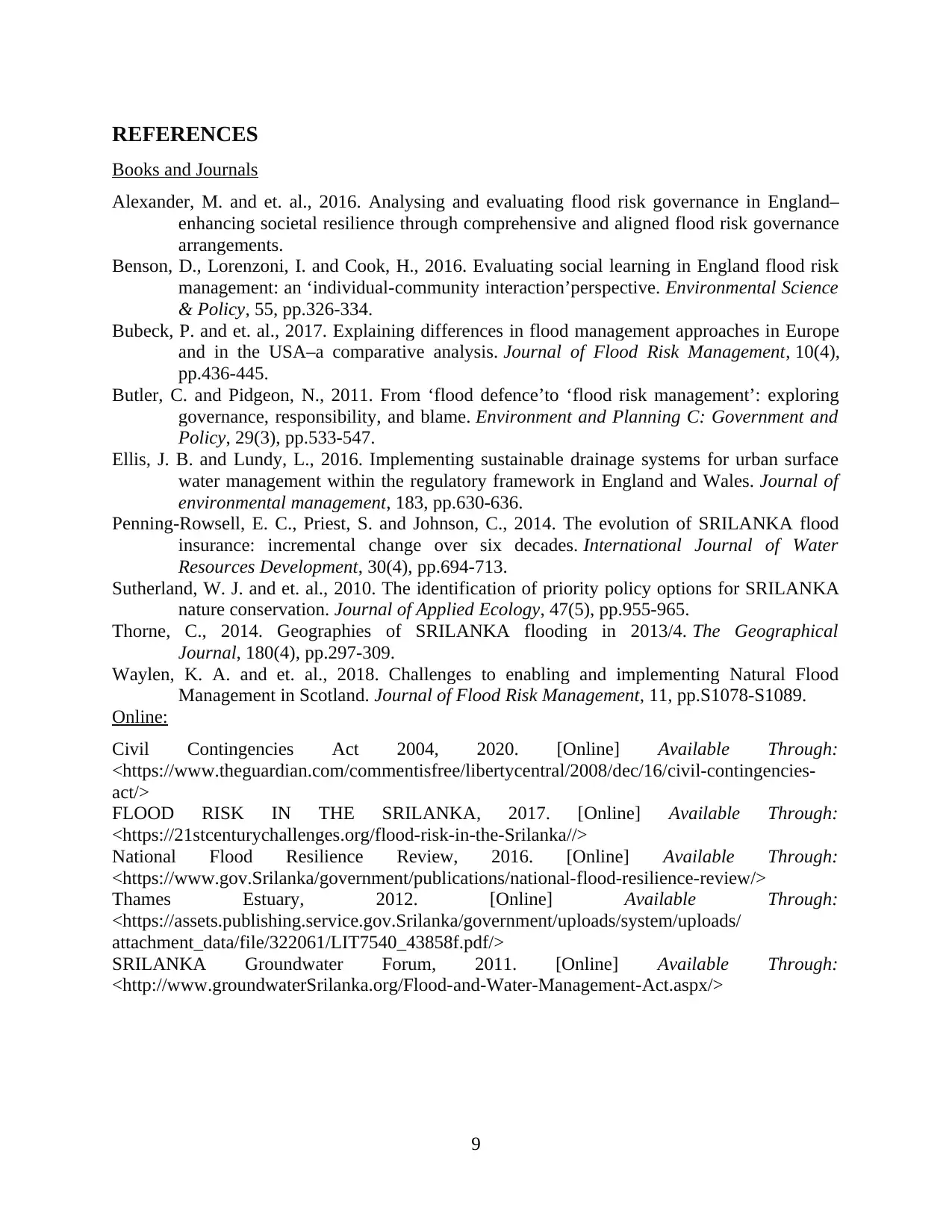
REFERENCES
Books and Journals
Alexander, M. and et. al., 2016. Analysing and evaluating flood risk governance in England–
enhancing societal resilience through comprehensive and aligned flood risk governance
arrangements.
Benson, D., Lorenzoni, I. and Cook, H., 2016. Evaluating social learning in England flood risk
management: an ‘individual-community interaction’perspective. Environmental Science
& Policy, 55, pp.326-334.
Bubeck, P. and et. al., 2017. Explaining differences in flood management approaches in Europe
and in the USA–a comparative analysis. Journal of Flood Risk Management, 10(4),
pp.436-445.
Butler, C. and Pidgeon, N., 2011. From ‘flood defence’to ‘flood risk management’: exploring
governance, responsibility, and blame. Environment and Planning C: Government and
Policy, 29(3), pp.533-547.
Ellis, J. B. and Lundy, L., 2016. Implementing sustainable drainage systems for urban surface
water management within the regulatory framework in England and Wales. Journal of
environmental management, 183, pp.630-636.
Penning-Rowsell, E. C., Priest, S. and Johnson, C., 2014. The evolution of SRILANKA flood
insurance: incremental change over six decades. International Journal of Water
Resources Development, 30(4), pp.694-713.
Sutherland, W. J. and et. al., 2010. The identification of priority policy options for SRILANKA
nature conservation. Journal of Applied Ecology, 47(5), pp.955-965.
Thorne, C., 2014. Geographies of SRILANKA flooding in 2013/4. The Geographical
Journal, 180(4), pp.297-309.
Waylen, K. A. and et. al., 2018. Challenges to enabling and implementing Natural Flood
Management in Scotland. Journal of Flood Risk Management, 11, pp.S1078-S1089.
Online:
Civil Contingencies Act 2004, 2020. [Online] Available Through:
<https://www.theguardian.com/commentisfree/libertycentral/2008/dec/16/civil-contingencies-
act/>
FLOOD RISK IN THE SRILANKA, 2017. [Online] Available Through:
<https://21stcenturychallenges.org/flood-risk-in-the-Srilanka//>
National Flood Resilience Review, 2016. [Online] Available Through:
<https://www.gov.Srilanka/government/publications/national-flood-resilience-review/>
Thames Estuary, 2012. [Online] Available Through:
<https://assets.publishing.service.gov.Srilanka/government/uploads/system/uploads/
attachment_data/file/322061/LIT7540_43858f.pdf/>
SRILANKA Groundwater Forum, 2011. [Online] Available Through:
<http://www.groundwaterSrilanka.org/Flood-and-Water-Management-Act.aspx/>
9
Books and Journals
Alexander, M. and et. al., 2016. Analysing and evaluating flood risk governance in England–
enhancing societal resilience through comprehensive and aligned flood risk governance
arrangements.
Benson, D., Lorenzoni, I. and Cook, H., 2016. Evaluating social learning in England flood risk
management: an ‘individual-community interaction’perspective. Environmental Science
& Policy, 55, pp.326-334.
Bubeck, P. and et. al., 2017. Explaining differences in flood management approaches in Europe
and in the USA–a comparative analysis. Journal of Flood Risk Management, 10(4),
pp.436-445.
Butler, C. and Pidgeon, N., 2011. From ‘flood defence’to ‘flood risk management’: exploring
governance, responsibility, and blame. Environment and Planning C: Government and
Policy, 29(3), pp.533-547.
Ellis, J. B. and Lundy, L., 2016. Implementing sustainable drainage systems for urban surface
water management within the regulatory framework in England and Wales. Journal of
environmental management, 183, pp.630-636.
Penning-Rowsell, E. C., Priest, S. and Johnson, C., 2014. The evolution of SRILANKA flood
insurance: incremental change over six decades. International Journal of Water
Resources Development, 30(4), pp.694-713.
Sutherland, W. J. and et. al., 2010. The identification of priority policy options for SRILANKA
nature conservation. Journal of Applied Ecology, 47(5), pp.955-965.
Thorne, C., 2014. Geographies of SRILANKA flooding in 2013/4. The Geographical
Journal, 180(4), pp.297-309.
Waylen, K. A. and et. al., 2018. Challenges to enabling and implementing Natural Flood
Management in Scotland. Journal of Flood Risk Management, 11, pp.S1078-S1089.
Online:
Civil Contingencies Act 2004, 2020. [Online] Available Through:
<https://www.theguardian.com/commentisfree/libertycentral/2008/dec/16/civil-contingencies-
act/>
FLOOD RISK IN THE SRILANKA, 2017. [Online] Available Through:
<https://21stcenturychallenges.org/flood-risk-in-the-Srilanka//>
National Flood Resilience Review, 2016. [Online] Available Through:
<https://www.gov.Srilanka/government/publications/national-flood-resilience-review/>
Thames Estuary, 2012. [Online] Available Through:
<https://assets.publishing.service.gov.Srilanka/government/uploads/system/uploads/
attachment_data/file/322061/LIT7540_43858f.pdf/>
SRILANKA Groundwater Forum, 2011. [Online] Available Through:
<http://www.groundwaterSrilanka.org/Flood-and-Water-Management-Act.aspx/>
9
⊘ This is a preview!⊘
Do you want full access?
Subscribe today to unlock all pages.

Trusted by 1+ million students worldwide
1 out of 9
Related Documents
Your All-in-One AI-Powered Toolkit for Academic Success.
+13062052269
info@desklib.com
Available 24*7 on WhatsApp / Email
![[object Object]](/_next/static/media/star-bottom.7253800d.svg)
Unlock your academic potential
Copyright © 2020–2025 A2Z Services. All Rights Reserved. Developed and managed by ZUCOL.




